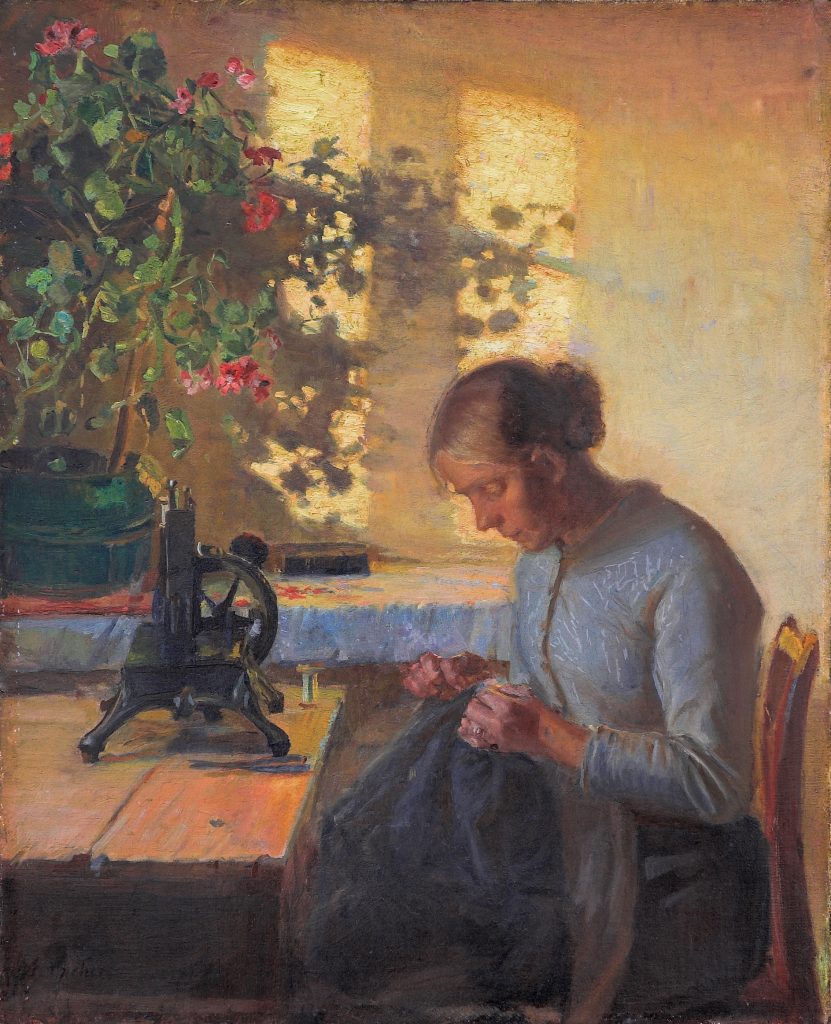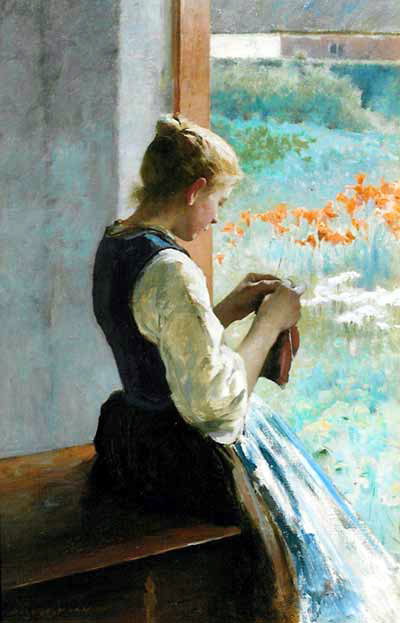
I min förra blogg började jag berätta om min karta över Augustas hemtrakter runt Kvillinge. Idag tar jag mig några cm västerut från Kvillinge kyrka på min karta, och hamnar med fingret på Lida gård.
1850 bodde här handlanden Eric Österlind. Han var svärfar till Augustas väninna Mina Stafström.
Dagboken 1851:
Den 27 Februari reste jag på Mina Stafströms bröllop. Dylika tillställningar äro sig alla lika, alltid ytterst tråkiga och sömniga. Himlen vet hvad der var för folk, ty mig föreföll det som hade jag bevistat en maskerad. Idel obekanta och ledsamma fysionomier, hvaraf jag slöt att societeten bestod af Norrköpingsbor. Herrarna rotade sig tillsammans i ett hörn af salen der de förblefvo hela afton, och fruntimmerna klädde stillatigande väggarna i förmaken, alldeles på Norrköpingsfaçon. Bruden såg rätt söt ut och hennes man var den personifierade stumheten. Klockan half tu fingo vi en ypperlig soupe, och sedan kronan blifvit afdansad och brudtärnorna dermed begåfvade, blef det ett complimenterande till höger och venster och slutligen afresa.
 Nu bosatte sig inte det unga paret på Lida utan på Fiskeby gård, där Gustaf drev Fiskeby pappersbruk. Men redan 1854 dog svärfar och Gustafs lillebror Per Vilhelm Österlind övertog Lida gård.
Nu bosatte sig inte det unga paret på Lida utan på Fiskeby gård, där Gustaf drev Fiskeby pappersbruk. Men redan 1854 dog svärfar och Gustafs lillebror Per Vilhelm Österlind övertog Lida gård.
Lida säteri 1802
Vi gör ett tidshopp tillbaka till 1802 på Lida. Då bodde här den pensionerade översten Jakob Erik Gripenwaldt.
22 januari föds en liten flicka på Lida. Hon är dotter till kusken Olof Hanqvist och pigan Maria Belin och döps till Eva Catharina. På Lida växer hon upp tillsammans med fyra syskon. Ibland kallas hon Carin, ibland Catharina eller Eva. Vid konfirmationen 1816 i Kvillinge kallas hon Karin.
1806 dör överstens hustru och 1817 säljer han sedan gården till Grosshandlare Eric Österlind. I mars 1818 flyttar överste Gripenwald och även familjen Hanqvist in till Norrköping. De flyttar in i kvarteret Rosen där kusken Hanqvist och hans fru fortsätter arbeta hos Gripenwaldt. Här försvinner Eva Catharina ur rullorna. Förmodligen fick hon arbete som piga, men vi vet inte var.
 Så dyker hon upp igen i vigselboken i St Olai församling.
Så dyker hon upp igen i vigselboken i St Olai församling.
19 oktober 1823 gifter sig jungfrun Eva Catharina Hanqvist med skomakargesällen Clas Gustaf Brandt. För de som läst Saras blogginlägg förra veckan är Eva Catharina Brandt eller Brantan, ingen ny bekantskap.
Paret Brandt tar sig nu an Clas Gustafs brorson som fosterbarn, förmodligen för att han är föräldralös men kanske också för att de inte får några egna barn. Clas Gustaf Brandt blir nu skomakaremästare. Det går bra för honom och han köper en egen gård i kvarteret Bakugnen, inte långt från kvarteret Rosen.
1832 säljs gården på auktion enligt Norrköpings tidningar. Gick inte affärerna tillräckligt bra? Hade de lånat till fastigheten och inte kunnat betala? Vi vet inte.
1833 dör Clas Gustaf plötsligt, dödsorsaken går inte att utläsa ur dödsboken, men i Norrköpings tidningar står det att det var vådligt. Eva Catharina blir änka vid 31års ålder.
Bouppteckningen visar att skulderna betydligt översteg tillgångarna. Det fanns skulder till flera textilfabrikörer, bland annat Johan Jakob Schubert och Arosenius. Vad betydde det? Köpte Brandts material hos dem? Eller handlade det om lån?
Men bouppteckningen visar även på att vi förmodligen hittat vår sömmerska. På tillgångssidan fanns inte mycket. Ett fickur och två silverteskedar och så en utdragssoffa för två personer samt några andra möbler. Men så står det där på sidan: Ett sybord och två mindre sybord.
För fostersonen går det inte så bra. Vid två tillfällen 1837 efterlyses den 12-åriga gossen som rymt från sitt uppfostringshem.
Norrköpings tidningar i augusti 1837:
Gossarne Pehr Gustaf Brandt och Berth Fredric Lagerwall, klädde i hwita tröjor och byxor, hafwa olofligen bortgått från härwarande uppfostrings-inrättning. Den, som om deras wistande har eller får nogon kunskap, anmodas att gifwa det tillkänna hos Fattigfogden Pettersson på Arbetshuset eller Polisgewaldiger Nystrand.
Som Sara skrev i sin blogg så försöker nu änkan Brandt att livnära sig på att sälja blomfröer. En viss ersättning från kommunen får hon också för att hon tar hand om fostersonen. Det redovisas noga i tidningen vilka som får understöd!
I slutet av 1840-talet dyker hon upp i Augustas värld
Hon är resande sömmerska i Kvillinge. Nu förstår vi bättre varför hon rör sig ledigt i trakten. Hon bodde ju i Kvillinge i 16 år och lärde säkert känna bygden och familjerna som bodde på de större gårdarna. Lida, Skärlöta, Gräslinge, Krusenhof, Loddby, Tåby. Det var ju främst där man hade råd att anställa en sömmerska. Vanliga bondhustrur, torparfruar, soldatfruar och backstugusittare hade varken råd eller användning för fina klänningar. Men Eva Catharina Brandt måste med tiden blivit väldigt skicklig som sömmerska. Hon är ju så efterfrågad så man måste boka in henne i förväg. Och Augusta får ju beröm för sina vackra klänningar!
Loddby d: 21 Augusti 1850
Sedan i går är fru Brandt här och ändrar mig ett par klädningar. Lejdenfrost geck åt staden på eftermiddagen och Christian Norstedt kom en stund derefter hit och berättade det han hört omtalas att jag varit i Strömstad och att jag der haft en charmant toilette.
 Säkert var det så att hon fick mat och husrum av sina kunder på gårdarna i Kvillinge. De blev hennes vänner. Hon ber Augustas mamma hälsa till Augusta i brevet hon skriver.
Säkert var det så att hon fick mat och husrum av sina kunder på gårdarna i Kvillinge. De blev hennes vänner. Hon ber Augustas mamma hälsa till Augusta i brevet hon skriver.
Och Branta blir kvar i Kvillinge ända till sin död, då hon enligt kyrkoboken dog av svaghet, 66 år gammal.
Själv undrar jag om det var hon som sydde Augustas vackra rosa sidenklänning jag provade på 1970-talet?
Bilder:
Huvudbild: Fishermans wife sewing, Anna Ancher
Lida gård 1940, Östergötlands arkivcentrum
Girl sewing, Hugo Salmson, Atheneum
“Interior in Strandgade, Sunlight on the Floor”, Vilhelm Hammershoi’s, Statens Museum for Kunst, smk.dk.
